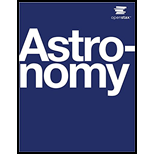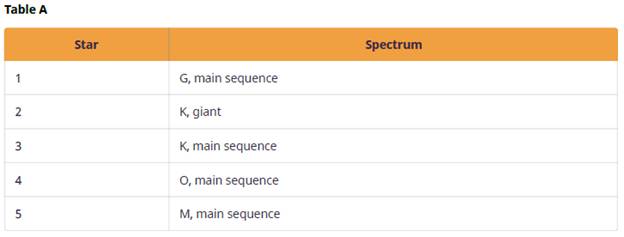
Astronomy
1st Edition
ISBN: 9781938168284
Author: Andrew Fraknoi; David Morrison; Sidney C. Wolff
Publisher: OpenStax
expand_more
expand_more
format_list_bulleted
Concept explainers
Textbook Question
Chapter 18, Problem 20E
Review this spectral data for five stars.

Which is the hottest? Coolest? Most luminous? Least luminous? In each case, give your reasoning.
Expert Solution & Answer
Trending nowThis is a popular solution!

Students have asked these similar questions
Answers with -1.828, -1.31 or 939.3 are not correct.
Three slits, each separated from its neighbor by d = 0.06 mm, are illuminated by a coherent light source of
wavelength 550 nm. The slits are extremely narrow. A screen is located L = 2.5 m from the slits. The
intensity on the centerline is 0.05 W. Consider a location on the screen x = 1.72 cm from the centerline.
a) Draw the phasors, according to the phasor model for the addition of harmonic waves, appropriate for this
location.
b) From the phasor diagram, calculate the intensity of light at this location.
A Jamin interferometer is a device for measuring or for comparing the indices of refraction of gases. A beam
of monochromatic light is split into two parts, each of which is directed along the axis of a separate cylindrical
tube before being recombined into a single beam that is viewed through a telescope. Suppose we are given the
following,
•
Length of each tube is L = 0.4 m.
• λ= 598 nm.
Both tubes are initially evacuated, and constructive interference is observed in the center of the field of view. As
air is slowly let into one of the tubes, the central field of view changes dark and back to bright a total of 198
times.
(a) What is the index of refraction for air?
(b) If the fringes can be counted to ±0.25 fringe, where one fringe is equivalent to one complete cycle of
intensity variation at the center of the field of view, to what accuracy can the index of refraction of air be
determined by this experiment?
Chapter 18 Solutions
Astronomy
Ch. 18 - How does the mass of the Sun compare with that of...Ch. 18 - Name and describe the three types of binary...Ch. 18 - Describe two ways of determining the diameter of a...Ch. 18 - What are the largest- and smallest-known values of...Ch. 18 - You are able to take spectra of both stars in an...Ch. 18 - Sketch an HR diagram. Label the axes. Show where...Ch. 18 - Describe what a typical star in the Galaxy would...Ch. 18 - How do we distinguish stars from brown dwarfs? How...Ch. 18 - Describe how the mass, luminosity, surface...Ch. 18 - One method to measure the diameter of a star is to...
Ch. 18 - We discussed in the chapter that about half of...Ch. 18 - Is the Sun an average star? Why or why not?Ch. 18 - Suppose you want to determine the average...Ch. 18 - Why do most known visual binaries have relatively...Ch. 18 - Figure 18.11 shows the light curve of a...Ch. 18 - There are fewer eclipsing binaries than...Ch. 18 - Within 50 light-years of the Sun, visual binaries...Ch. 18 - Which is easier to observe at large distances-a...Ch. 18 - The eclipsing binary Algol drops from maximum to...Ch. 18 - Review this spectral data for five stars. Which is...Ch. 18 - Which changes by the largest factor along the main...Ch. 18 - Suppose you want to search for brown dwarfs using...Ch. 18 - An astronomer discovers a type-M star with a large...Ch. 18 - Approximately 6000 stars are bright enough to be...Ch. 18 - Use the data in Appendix J to plot an HR diagram...Ch. 18 - Use the diagram you have drawn for Exercise 18.25...Ch. 18 - Use the data in Appendix I to plot an HR diagram...Ch. 18 - If a visual binary system were to have two...Ch. 18 - Two stars are in a visual binary star system that...Ch. 18 - Describe the spectra for a spectroscopic binary...Ch. 18 - Figure 18.7 shows the velocity of two stars in a...Ch. 18 - You go out stargazing one night, and someone asks...Ch. 18 - If you were to compare three stars with the same...Ch. 18 - Are supergiant stars also extremely massive?...Ch. 18 - Consider the following data on four stars: Which...Ch. 18 - If two stars are in a binary system with a...Ch. 18 - It is possible that stars as much as 200 times the...Ch. 18 - The lowest mass for a true star is 1/12 the mass...Ch. 18 - Spectral types are an indicator of temperature....Ch. 18 - We can estimate the masses of most of the stars in...Ch. 18 - In Diameters of Stars, the relative diameters of...Ch. 18 - Now calculate the radius of Sirius’ white dwarf...Ch. 18 - How does this radius of Sirius B compare with that...Ch. 18 - From the previous calculations and the results...Ch. 18 - How much would you weigh if you were suddenly...Ch. 18 - The star Betelgeuse has a temperature of 3400 K...Ch. 18 - Using the information provided in Table 18.1, what...Ch. 18 - Confirm that the angular diameter of the Sun of...Ch. 18 - An eclipsing binary star system is observed with...Ch. 18 - If a 100 solar mass star were to have a luminosity...Ch. 18 - If Betelgeuse had a mass that was 25 times that of...
Additional Science Textbook Solutions
Find more solutions based on key concepts
WHAT IF? Is allopatric speciation more likely to occur on an island close to a mainland or on a more isolated i...
Campbell Biology in Focus (2nd Edition)
A source of electromagnetic radiation produces infrared light. Which of the following could be the wavelength ...
Chemistry: The Central Science (14th Edition)
10.71 Identify each of the following as an acid or a base: (10.1)
H2SO4
RbOH
Ca(OH)2
HI
...
Chemistry: An Introduction to General, Organic, and Biological Chemistry (13th Edition)
The bioremediation process shown in the photograph is used to remove benzene and other hydrocarbons from soil c...
Microbiology: An Introduction
53. This reaction was monitored as a function of time:
A plot of In[A] versus time yields a straight ...
Chemistry: Structure and Properties (2nd Edition)
39. What is the sound intensity of a whisper at a distance of 2.0 m, in W/m2? What is the corresponding sound i...
College Physics: A Strategic Approach (3rd Edition)
Knowledge Booster
Learn more about
Need a deep-dive on the concept behind this application? Look no further. Learn more about this topic, physics and related others by exploring similar questions and additional content below.Similar questions
- 1. An arrangement of three charges is shown below where q₁ = 1.6 × 10-19 C, q2 = -1.6×10-19 C, and q3 3.2 x 10-19 C. 2 cm Y 93 92 91 X 3 cm (a) Calculate the magnitude and direction of the net force on q₁. (b) Sketch the direction of the forces on qiarrow_forward(Figure 1)In each case let w be the weight of the suspended crate full of priceless art objects. The strut is uniform and also has weight w Find the direction of the force exerted on the strut by the pivot in the arrangement (a). Express your answer in degrees. Find the tension Tb in the cable in the arrangement (b). Express your answer in terms of w. Find the magnitude of the force exerted on the strut by the pivot in the arrangement (b). Express your answer in terms of w.arrow_forward(Figure 1)In each case let ww be the weight of the suspended crate full of priceless art objects. The strut is uniform and also has weight w. Find the direction of the force exerted on the strut by the pivot in the arrangement (b). Express your answer in degrees.arrow_forward
- A 70.0 cm, uniform, 40.0 N shelf is supported horizontally by two vertical wires attached to the sloping ceiling (Figure 1). A very small 20.0 N tool is placed on the shelf midway between the points where the wires are attached to it. Find the tension in the left-hand wire. Express your answer with the appropriate units.arrow_forwardFind the total bind Mev. binding energy for 13 Carbon, 6C (atomic mass = 13.0033554)arrow_forwardWhat is the 27 energy absorbed in this endothermic Auclear reaction 2] Al + 'n → 27 Mg + ! H? (The atom mass of "Al is 26.981539u. and that of 11 Mg is 26.984341u) MeVarrow_forward
- What is the energy released in this nuclear reaction 1 F + "', H-1 O+ He? 19 19 16 (The atomic mass of 1F is 18.998403 u, and that of 20 is 15.9949154) MeV.arrow_forwardWhat is the energy released in this B+ nuclear reaction خالد 2½ Al w/ Mg + ie? (The atomic mass of 11 Al is 23.9999394 and that > of 12 Mg is 23.985041 u) MeV.arrow_forwardWhat is the energy released / absorbed in this nuclear reaction 14 N+ & He → » O + ! N? (The atomic mass of 14 N is 14.003074u. 17N+ and that of 10 is 16.9991324). MeVarrow_forward
- Can someone help me answer this question thanks.arrow_forwardCan someone help me with this question thanks.arrow_forward4B. Four electrons are located on the corners of a square, one on each corner, with the sides of the square being 25 cm long. a) Draw a sketch of the scenario and use your sketch to b) Determine the total force (magnitude and direction) on one of the electrons from the other three?arrow_forward
arrow_back_ios
SEE MORE QUESTIONS
arrow_forward_ios
Recommended textbooks for you
 AstronomyPhysicsISBN:9781938168284Author:Andrew Fraknoi; David Morrison; Sidney C. WolffPublisher:OpenStax
AstronomyPhysicsISBN:9781938168284Author:Andrew Fraknoi; David Morrison; Sidney C. WolffPublisher:OpenStax Foundations of Astronomy (MindTap Course List)PhysicsISBN:9781337399920Author:Michael A. Seeds, Dana BackmanPublisher:Cengage Learning
Foundations of Astronomy (MindTap Course List)PhysicsISBN:9781337399920Author:Michael A. Seeds, Dana BackmanPublisher:Cengage Learning Stars and Galaxies (MindTap Course List)PhysicsISBN:9781337399944Author:Michael A. SeedsPublisher:Cengage Learning
Stars and Galaxies (MindTap Course List)PhysicsISBN:9781337399944Author:Michael A. SeedsPublisher:Cengage Learning Stars and GalaxiesPhysicsISBN:9781305120785Author:Michael A. Seeds, Dana BackmanPublisher:Cengage Learning
Stars and GalaxiesPhysicsISBN:9781305120785Author:Michael A. Seeds, Dana BackmanPublisher:Cengage Learning An Introduction to Physical SciencePhysicsISBN:9781305079137Author:James Shipman, Jerry D. Wilson, Charles A. Higgins, Omar TorresPublisher:Cengage Learning
An Introduction to Physical SciencePhysicsISBN:9781305079137Author:James Shipman, Jerry D. Wilson, Charles A. Higgins, Omar TorresPublisher:Cengage Learning

Astronomy
Physics
ISBN:9781938168284
Author:Andrew Fraknoi; David Morrison; Sidney C. Wolff
Publisher:OpenStax

Foundations of Astronomy (MindTap Course List)
Physics
ISBN:9781337399920
Author:Michael A. Seeds, Dana Backman
Publisher:Cengage Learning

Stars and Galaxies (MindTap Course List)
Physics
ISBN:9781337399944
Author:Michael A. Seeds
Publisher:Cengage Learning

Stars and Galaxies
Physics
ISBN:9781305120785
Author:Michael A. Seeds, Dana Backman
Publisher:Cengage Learning

An Introduction to Physical Science
Physics
ISBN:9781305079137
Author:James Shipman, Jerry D. Wilson, Charles A. Higgins, Omar Torres
Publisher:Cengage Learning